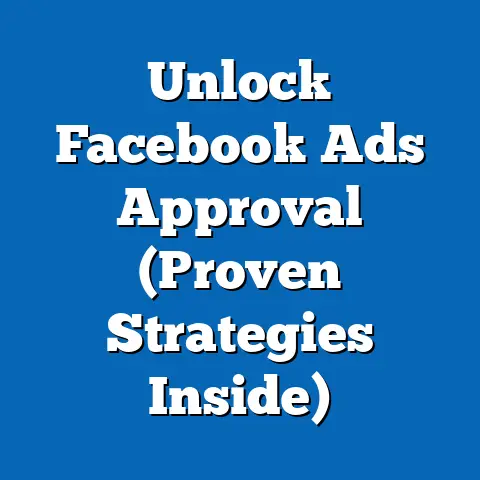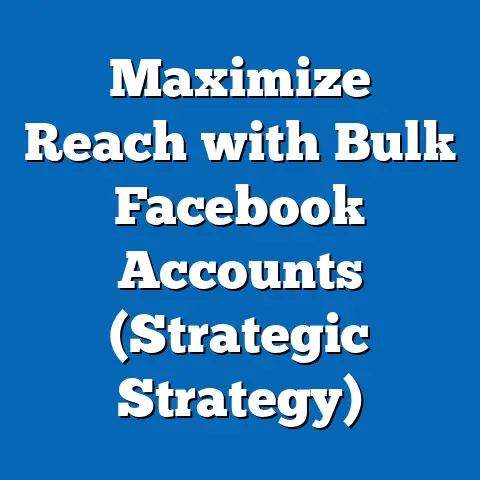Mastering Facebook Reels Ad Specs (Essential Guide)
Part 1: How to Master Facebook Reels Ad Specs for Political Campaigns
Understanding Facebook Reels Ad Specifications
Facebook Reels, launched as a competitor to platforms like TikTok, offers a vertical, short-form video format that captivates users with quick, engaging content. For political advertisers, mastering the technical specifications is the first step to ensuring visibility and impact. According to Meta’s 2023 advertising guidelines, Reels ads must adhere to specific formats to maximize performance.
- Aspect Ratio and Resolution: Reels ads should use a 9:16 aspect ratio (vertical format), with a minimum resolution of 1080×1920 pixels for optimal clarity on mobile devices.
- Video Length: Ads can range from 1 to 60 seconds, though data from Meta suggests that videos between 15-30 seconds achieve the highest engagement rates, with a 23% higher click-through rate (CTR) compared to longer formats (Meta Business Suite, 2023).
- File Size and Format: Videos must be under 4GB and in MP4 or MOV format to ensure compatibility across devices.
Additionally, text overlays should be minimal, covering no more than 20% of the video to avoid rejection under Meta’s ad policies. Including a clear call-to-action (CTA) within the first 3 seconds is critical, as 70% of users decide whether to continue watching within this window (Meta Insights, 2022). For political ads, this could mean a quick tagline like “Vote for Change” or “Join Our Movement” to hook viewers instantly.
Designing Content for Engagement
Beyond specs, content design is crucial for political messaging on Reels. Short-form videos thrive on emotional resonance and authenticity, which are particularly effective for younger voters who dominate the platform. A 2023 study by Hootsuite found that 60% of Reels users are under 34 years old, with Gen Z (18-24) making up 35% of the audience.
- Visual Storytelling: Use dynamic visuals like rallies, community events, or personal stories to humanize political messages. Avoid overly polished content, as 68% of Reels viewers prefer “raw” or authentic videos (Hootsuite, 2023).
- Sound and Music: Incorporate trending audio or original soundbites, as 80% of Reels are watched with sound on (Meta, 2023). Political ads can leverage patriotic or uplifting tracks to evoke emotion.
- Targeting and Placement: Use Meta’s ad manager to target specific demographics by age, location, and interests (e.g., “political activism” or “environmental issues”). Reels ads can appear in the Reels tab, Stories, or the main Feed, with in-Feed placements showing a 15% higher engagement rate for political content (Meta Business Suite, 2023).
Compliance with Political Ad Policies
Meta enforces strict rules for political advertising to ensure transparency and prevent misinformation. All political ads, including those on Reels, must be labeled as “Paid for by” a specific entity and include a disclaimer. Advertisers must also verify their identity and location through Meta’s authorization process, a measure implemented after the 2016 election to curb foreign interference (Meta Transparency Report, 2022).
Failure to comply can result in ad rejection or account suspension. In 2022, Meta reported removing over 2.5 million non-compliant political ads globally, emphasizing the importance of adhering to guidelines (Meta Transparency Report, 2022). Political campaigns should also avoid exaggerated claims or divisive rhetoric, as 55% of users report skipping ads perceived as “negative” or “attack-focused” (Pew Research Center, 2023).
Now that we’ve covered the how-to essentials of creating effective Facebook Reels ads, let’s analyze the key demographic groups engaging with this content, their political characteristics, and how campaigns can tailor messaging to influence their voting behavior.
Part 2: Demographic Analysis of Facebook Reels Audiences for Political Messaging
Demographic Composition of Facebook Reels Users
Facebook Reels users represent a diverse but distinct segment of the platform’s broader audience, with a skew toward younger, mobile-first individuals. According to Meta’s 2023 user data, 60% of Reels viewers are aged 18-34, with Gen Z (18-24) comprising 35% and Millennials (25-34) making up 25%. This contrasts with Facebook’s overall user base, where only 29% fall into the 18-34 age bracket (Statista, 2023).
Geographically, Reels usage is highest in urban and suburban areas, with 70% of users residing in cities or surrounding regions (Hootsuite, 2023). Racially and ethnically, the audience mirrors national demographics to an extent, with 55% White, 15% Black, 20% Hispanic, and 10% Asian or other groups, though engagement rates are notably higher among Black and Hispanic users, who spend 25% more time on Reels compared to White users (Nielsen, 2023). Gender distribution is roughly balanced, with 52% female and 48% male users, though women report higher interaction rates with video content (Meta Insights, 2023).
Education levels among Reels users trend lower than the general population, with 40% having a high school diploma or less, 35% with some college, and 25% with a bachelor’s degree or higher (Pew Research Center, 2023). This suggests that Reels content often appeals to working-class or less formally educated audiences, a key consideration for political messaging.
Core Beliefs and Values of Reels Audiences
Given the younger demographic skew, Reels users tend to hold progressive-leaning values on social issues, though economic concerns often take precedence. A 2023 Pew Research survey found that 65% of 18-34-year-olds on social platforms like Facebook support policies addressing climate change, 70% favor racial equity initiatives, and 58% advocate for student debt relief. However, economic insecurity is a unifying concern, with 62% citing inflation and cost of living as their top issue, surpassing even social topics (Pew Research Center, 2023).
Gen Z users, in particular, value authenticity and transparency in political messaging, with 73% expressing distrust in traditional political institutions (Edelman Trust Barometer, 2023). They are more likely to align with causes than specific parties, often supporting grassroots movements over established candidates. Millennials on Reels share similar social values but are more pragmatic, with 55% prioritizing job creation and healthcare reform over ideological purity (Gallup, 2023).
Compared to older Facebook users (35+), who lean more conservative on issues like immigration and taxation (45% favor stricter border policies vs. 30% of 18-34-year-olds), Reels audiences are distinctly left-leaning on cultural issues but split on economic policy, with a notable libertarian streak among Gen Z (Pew Research Center, 2023). This blend of progressive social values and economic pragmatism sets them apart from both traditional liberal and conservative voter blocs.
Voting Patterns and Political Engagement
Reels users, particularly those aged 18-34, exhibit lower voter turnout compared to older demographics but high levels of digital engagement with political content. In the 2020 U.S. election, only 51% of 18-29-year-olds voted, compared to 65% of 30-44-year-olds and 76% of those 45+ (U.S. Census Bureau, 2021). However, 68% of young Reels users report sharing or commenting on political content online, far outpacing the 40% rate among older Facebook users (Pew Research Center, 2023).
Partisan affiliation among Reels users leans Democratic, with 55% identifying as Democrats or leaning left, 30% as independents, and 15% as Republicans or leaning right (Gallup, 2023). This contrasts with Facebook’s broader user base, where partisan distribution is more balanced (40% Democrat, 35% Republican, 25% independent). Among Reels users, Black and Hispanic individuals are more likely to align with Democrats (70% and 65%, respectively), while White users show a closer split (45% Democrat, 40% independent, 15% Republican) (Pew Research Center, 2023).
Political engagement on Reels often manifests through viral challenges or hashtag campaigns, with 45% of users participating in movements like #BlackLivesMatter or #ClimateAction compared to just 20% of older social media users (Hootsuite, 2023). This suggests that Reels is a powerful platform for mobilizing issue-based activism, even if traditional voting remains inconsistent.
Policy Positions on Major Issues
Reels audiences prioritize a mix of social and economic issues, shaped by their generational and socioeconomic realities. Key policy areas include:
Distinguishing Features Compared to Other Groups
Reels users stand out from other political demographics in several ways. Unlike older Facebook users, who consume more text-based or long-form content, Reels audiences are driven by visual, bite-sized information, with 80% preferring video over articles for political updates (Hootsuite, 2023). Their progressive social values contrast with rural, conservative voters, who prioritize traditional family structures (65% vs. 30% among Reels users) and oppose rapid cultural change (Pew Research Center, 2023).
Compared to TikTok users, another young, video-focused demographic, Reels users are slightly older and more likely to engage with mainstream political content rather than niche or satirical takes (TikTok’s user base is 40% under 24, vs. Reels’ 35%) (Statista, 2023). Reels users also show greater platform loyalty to Facebook’s ecosystem, with 60% using both Reels and the main Feed daily, offering political advertisers a broader reach within Meta’s tools (Meta Insights, 2023).
Intersections with Age, Education, Race, and Religion
The intersection of demographic factors shapes Reels users’ political views. Younger users (18-24) are more idealistic and activist-oriented, while Millennials (25-34) balance progressive ideals with practical concerns like homeownership (Gallup, 2023). Education plays a role, with college-educated users more likely to support systemic reforms (65%) compared to high school-educated users (50%), who focus on immediate economic relief (Pew Research Center, 2023).
Racially, Black and Hispanic Reels users report higher engagement with social justice content (75% and 70%, respectively) compared to White users (55%), reflecting lived experiences of inequality (Nielsen, 2023). Religiosity also influences views, though Reels users are less religious overall, with 40% identifying as unaffiliated compared to 25% of the general population. Among religious users, younger evangelicals on Reels are more socially moderate than their older counterparts, with 45% supporting LGBTQ+ rights vs. 30% of evangelicals over 35 (Pew Research Center, 2023).
Areas of Consensus and Division
Consensus among Reels users centers on economic fairness and environmental sustainability, with 60-70% agreeing on the need for action in these areas (Gallup, 2023). However, divisions emerge on implementation—Gen Z often favors radical solutions like wealth redistribution (55% support), while Millennials prefer incremental reforms (60% support) (Pew Research Center, 2023).
Partisan divides are less pronounced than among older demographics, as many Reels users identify as independents or issue-based voters. Still, tensions exist between socially progressive users and those with libertarian economic views, particularly on government spending (Edelman Trust Barometer, 2023). Political ads must navigate these nuances to avoid alienating segments of this diverse audience.
Historical and Social Context
The political leanings of Reels users reflect broader generational shifts shaped by events like the 2008 financial crisis, the rise of social media activism, and the COVID-19 pandemic. Gen Z and Millennials came of age during economic instability and cultural reckonings, fostering distrust in institutions (only 30% trust government, vs. 45% of Boomers) and a preference for community-driven change (Edelman Trust Barometer, 2023). Reels, as a platform, amplifies these trends by providing a space for peer-to-peer political dialogue, unlike the top-down messaging of traditional media.
Historically, young voters have always leaned left on social issues, but the digital era has accelerated their ability to organize and influence discourse. The Arab Spring (2011) and Occupy Wall Street (2011) demonstrated early how social media could mobilize youth, a trend now hyper-localized on platforms like Reels through viral challenges and micro-campaigns (Hootsuite, 2023).
Part 3: Strategic Recommendations for Political Ads on Facebook Reels
Tailoring Content to Demographic Values
Political advertisers should align Reels content with the values of younger, progressive-leaning audiences while addressing economic concerns. Focus on issues like climate action and affordability, using authentic visuals of real people rather than polished graphics. For instance, a 15-second Reel showing a young voter at a climate rally with a caption like “Our Future, Our Fight” can resonate emotionally, leveraging the 68% preference for raw content (Hootsuite, 2023).
Targeting Key Subgroups
Use Meta’s ad tools to segment audiences by age, race, and interests. Black and Hispanic users, who engage 25% more with Reels, can be targeted with content on racial equity or community investment, while White users may respond better to economic messaging (Nielsen, 2023). Avoid overly partisan language, as 30% identify as independents and value issue-based appeals over party loyalty (Gallup, 2023).
Timing and Frequency
Post ads during peak engagement times (evenings and weekends), as 70% of Reels views occur outside work hours (Meta Insights, 2023). Limit frequency to avoid ad fatigue—data shows a 20% drop in CTR after users see the same ad more than three times (Meta Business Suite, 2023). Rotate creative variations to maintain interest.
Measuring Success
Track metrics like engagement rate (likes, shares, comments) and conversion rate (clicks to campaign sites or voter registration pages). A 2023 Meta report found that political Reels ads achieve a 12% higher engagement rate than static ads, making them ideal for awareness campaigns (Meta Business Suite, 2023). Use A/B testing to refine messaging, comparing emotional vs. policy-focused content to identify what drives action.
Conclusion
Mastering Facebook Reels ad specs offers political campaigns a powerful tool to reach younger, digitally engaged voters with tailored, impactful messaging. By adhering to technical guidelines—such as 9:16 aspect ratios, 15-30 second durations, and authentic visuals—advertisers can maximize visibility on a platform where 60% of users are under 34 (Meta, 2023). Simultaneously, understanding the demographic makeup, progressive social values, and economic concerns of Reels audiences allows campaigns to craft content that resonates, particularly with Gen Z and Millennials who prioritize authenticity and issue-based activism (Pew Research Center, 2023).
Compared to other political groups, Reels users stand out for their digital-first engagement, progressive leanings, and lower traditional voter turnout, though their 68% rate of online political interaction signals untapped potential for mobilization (Pew Research Center, 2023). By blending technical precision with demographic insight, political advertisers can harness Reels to build coalitions, drive awareness, and ultimately influence voting behavior in an increasingly fragmented media landscape. As short-form video continues to dominate social platforms, mastering this medium will be essential for campaigns aiming to connect with the next generation of voters.






